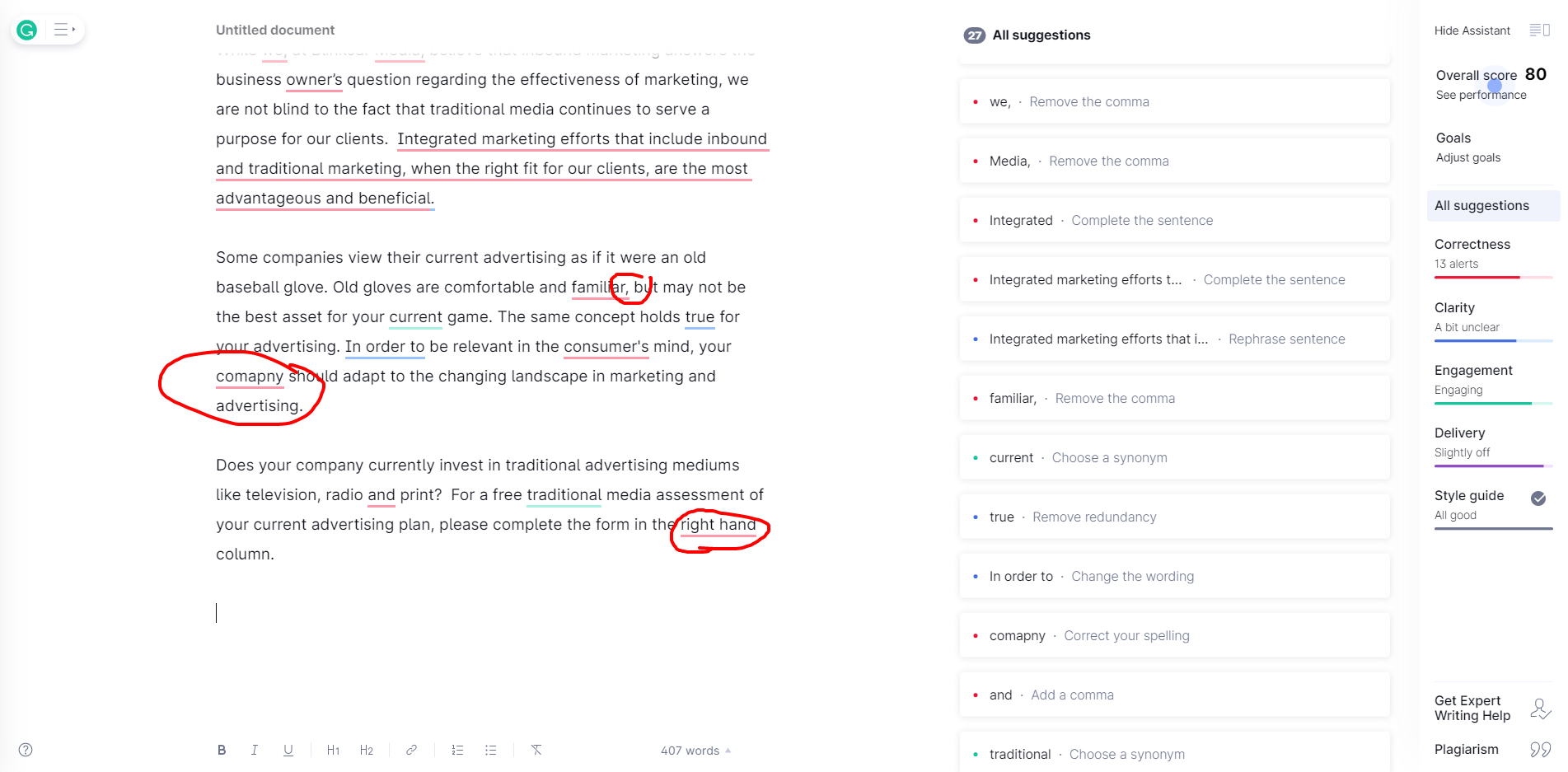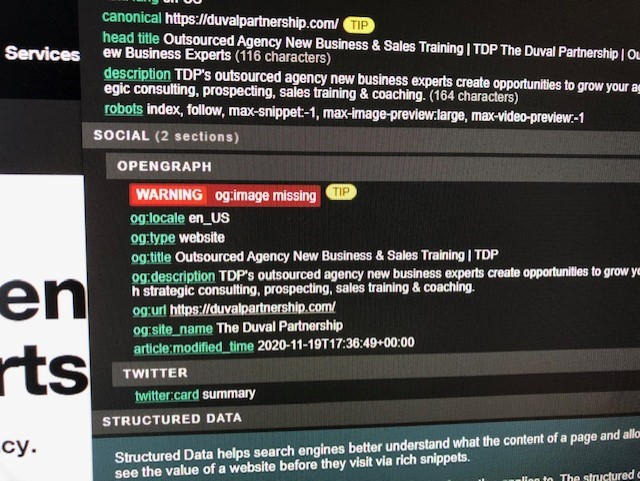Imagine this. You have a great conversation with a mutual acquaintance who just may turn out to be your next client. Their needs are perfectly aligned with your agency’s capabilities. After the call, they share your agency’s website with their team, fully expecting the level of enthusiasm to be contagious. But...when you next speak with this prospective client, their tone is decidedly tepid. It turns out, not only did their team encounter a difficult-to-navigate website (with typos!), nobody could figure out what your agency does. It reflected poorly on everyone, and the opportunity is no longer there. Big bummer.

Surely, your agency’s website is better than that. However, it almost certainly has *some* issues, and by now, your team is probably blind to them—if they are really looking at your agency's website at all.
These “issues” create missed opportunities for your agency. It would be a gift for anyone to tell you about their experience with your website and how it has affected their likelihood to do business with you. In reality, people don’t bother. They just drop off and go elsewhere. This post is about helping you find and correct those annoying little website problems that have escaped notice and are costing you money.
I’ve made a list of six ways to fix common issues we encounter when conducting agency audits. None of them are surprising. They occur more often than you would think. And they are all easily fixable. These small things can make a big difference in whether your agency presents as polished and competent to future clients.
Six easy content fixes to improve your agency’s new business “game”
1. Get better at curating your content.
This goes for work, blog posts, articles, and case studies. Work that is more than a few years old should usually be retired — unless it’s going to live in a “greatest hits archive” for well-known earlier work. If it shouldn’t be retired, it may need to be re-skinned to de-emphasize the date and talk about the work in current, but still accurate, terms, and to include more recent developments.
For perspective, we typically deem work from over three years ago as too old to help us generate interest. Even more so if the team members who worked on it are no longer part of the agency. If your site features a lot of older work, chances are it’s not helping as much as you think — and it might be doing the opposite. For example, if much of the agency’s work is older than three years old, it might make prospects think you haven’t been doing much of value in recent years and that the agency is post-heydey and on the decline.
Older blog posts that still attract a lot of traffic can be updated for accuracy, relevance, and polish, with a new publish date. Others might be retired and redirected elsewhere. When curating, remember that traffic volume isn't everything. If a post doesn't reflect favorably on the agency, you should consider how much its visitor count helps you.
The more content you have on your site, the more likely it is working against you in places. Broken links, outdated, irrelevant, and sloppy content can all make your agency appear less “expert” than it truly is. When it comes to the number of website pages, work, and blog posts, quality is more important than quantity.
For new business purposes, three to five strong examples of work and thought leadership per target audience should be sufficient and is far preferable to 25 pieces of content that fail to demonstrate the agency's results and expertise. Delegate your agency's resources accordingly.

2. Make content more accessible.
This is more of a user experience issue, but it also has to do with how content is positioned. Here are a few examples of situations where agencies miss opportunities with content accessibility.
- They hide case studies on a blog, where they are mixed in with other blog posts.
- They use thoughtless titles for work and case studies. Typically, you’d want to have the client’s name and a description of the challenge that was solved through the agency’s work. In some cases, the campaign title may also make sense. The bottom line is: without a clear and compelling title, most people won’t click through to learn what the agency did.
- They don’t use filter buttons or tags to make it easy for prospects to sort and locate work, case studies, and other content. For example, if case studies are mixed in with other work examples, it would be useful to separate the higher-value case studies from standalone work. If the agency serves clients in multiple verticals, it would help to sort all work by vertical. If the agency has multiple core skill competencies, it might be desirable to sort work by type.
Content accessibility strategies and sensible sorting categories will vary from agency to agency. Still, they all start from the same question: “How can I help my prospective clients find the most relevant information as easily as possible?”
3. Align content with new business strategy.
If your agency has a blog or actively posts to social media, this is for you. Often, the people responsible for content strategy and production are fairly removed (if not entirely divorced) from the new business team. This leads to divergent content goals and agency resources spent on content that may not realize its intended ROI.
While there are agency audiences that go beyond new business targets (such as potential employees and current clients), when most organizations invest in a blog, there is an expectation that it will play some role in lead generation. Better still, it might provide sales-supporting content throughout the customer journey. However, when those responsible for content production and new business strategy are not on the same page, those goals are unlikely to be met.
The new business team (including agency leadership) identifies the new business targets and go-to-market strategies for the year. But the content production team may be entirely in the dark about what those are. Or, they may only have some vague ballpark understanding. The result is content that doesn’t speak effectively to the agency’s prospective clients and has little to no new business value.
If your new business team is constantly asking for new usable content, and your blog writers wonder why people in new business aren’t using their work, this is probably why.
4. Fix overlooked typos.
This one is self-explanatory. We're better than this, and yet it still happens.
We continue to see avoidable errors on agency websites in the course of our content audits, including duplication “and and,” missing or extra commas and hyphens, in addition to random typos. These are easily fixed by cutting and pasting the copy through an editing tool like Grammarly to flag potential errors.

The usual suspects are pages that have been added and updated on an ad hoc basis. When a new site is created, or copy is updated as part of a larger project, there are usually multiple copyediting and approval stages to prevent issues. But when a case study or new page is published independently, it might not be subject to as many layers of review.
5. Update abandoned social media accounts and directory profiles.
It’s not a good look to have neglected agency profiles scattered across the internet. Do a Google search for your agency and see what comes up in the first few pages of results. The odds are that you have abandoned directory listings featuring outdated iterations of your agency positioning. Perhaps your agency has “forgotten” social media accounts as well.
For directory listings, evaluate which are worth keeping and which you might be better off deleting. (TIP: If they come up in the first few pages of search results, you are probably better off taking advantage of that visibility and updating the listing to help drive leads to your agency). Keep a list of all your agency’s listings and circle back once a year, or when the agency undergoes a positioning update, to ensure you are taking advantage of every opportunity on each platform to present your agency in the best light.
For social profiles, use it or lose it. It doesn’t help your agency to have a “presence” on Facebook if no one has posted to the account for the past two years. In fact, it reflects negatively. If it’s not important enough for your agency to post regularly and engage with followers, maybe your agency doesn’t need to be on that platform.
We often find that neglected social profiles don't even feature the agency's current branding. One profile is a time capsule from 2015, and another is from 2018, while the agency is living in 2021. If an agency has multiple locations or has undergone M&A, this issue may be magnified.
There are higher expectations on social media for brands that provide advertising and marketing services. The obvious question is always, "if you can't do this for yourself, how can you do it for me?"
As I addressed earlier, social media content should also be informed by new business strategy. Figure out where you truly need to have a presence and then create a plan to BE there.

6. Address mismatched metadata.
When your agency updates its messaging, don’t forget to update the SEO meta description. Maybe the agency tagline has changed, or the core services, or the way the agency is described. Presenting misaligned or contradictory information about your agency introduces confusion and seems sloppy.
As with the typos, it may be that your core site pages don't reflect this issue because they've been subject to greater scrutiny. Pages that have been updated or added later on an ad hoc basis may be more likely to have a meta description mismatch.
Admittedly, this is less common than the other items I've addressed, but we encounter it often enough to recommend that you include it on your agency's checklist.
Your metadata feeds into the information Google presents in its search results, so you may encounter this when doing a search on your agency. You can also check your site's backend, but I often find it easier to use META SEO inspector, a free Google plugin you can install in your Chrome toolbar. SEO META in 1 CLICK and SEOquake are other similar apps.
Parting thoughts
Your agency may be facing other, larger-scale challenges, but because everything on this list is easy to tackle, these mistakes are in a class of their own. These are all quick wins.
Delegate some resources to do a quick check for these “low hanging fruit” issues and correct any that you find. It would be a shame to endanger new business opportunities over anything so easily fixed.
We'll help you identify missed opportunities in your prospect-facing content. Learn about our Agency Audit:
Read more:
- How Can the B2B Buyer Experience Help Grow Your Agency?
- How An Agency Brand Audit Can Supercharge New Business
- Why You Should Consider Lead-Gen Tactics for Your Agency Website
- Will Your Agency Website Generate New Business, or Sabotage It?
- How to Make Agency Directories Part of Your New Business Strategy
- Getting Found: The Fight for Agency New Business Starts At Search
Image credits: Photo by Markus Winkler on Unsplash; Photo by Jessica Ruscello on Unsplash.



